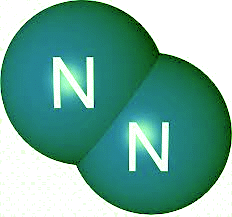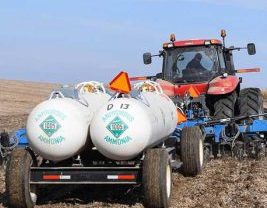  Earth's atmosphere contains many gases. The major component is nitrogen gas N2, a colourless, odourless and tasteless gas whose molecules are composed of two nitrogen atoms with atomic number 7.
Earth's atmosphere contains many gases. The major component is nitrogen gas N2, a colourless, odourless and tasteless gas whose molecules are composed of two nitrogen atoms with atomic number 7. Nitrogen makes up 78% of the air we breathe. Another 21% is oxygen, along with just 1% argon, and traces of carbon dioxide, krypton and hydrogen. There are also miniscule amounts of nitrous oxide, neon, helium, methane, xenon, ozone, iodine, carbon monoxide, and ammonia. In the nitrogen molecule N2 there is a strong triple covalent bond between the nitrogen atoms, which is difficult to break apart. However, when these bonds do break, the resulting products are often highly reactive. Nitrogen atoms are part of several types of pollutants; combustion in the presence of nitrogen gas, such as in automobile engines, can generate nitric oxide (NO) and nitrogen dioxide (NO2). Both gases are poisonous on their own, and also contribute to the production of smog and acid rain, along with sulphur dioxide.  Commercially produced nitrogen is used as an inert (oxygen-free) gas for food packaging, and liquid nitrogen is used in cryogenic applications, particularly in the medical field. Nitrogen gas can be used to manufacture ammonia (NH3), which is used extensively to produce chemical fertilizers. Many industrially important compounds such as ammonia, nitric acid, and organic nitrates (fertilizers such as anhydrous ammonia (NH3), propellants and explosives) contain nitrogen.
Commercially produced nitrogen is used as an inert (oxygen-free) gas for food packaging, and liquid nitrogen is used in cryogenic applications, particularly in the medical field. Nitrogen gas can be used to manufacture ammonia (NH3), which is used extensively to produce chemical fertilizers. Many industrially important compounds such as ammonia, nitric acid, and organic nitrates (fertilizers such as anhydrous ammonia (NH3), propellants and explosives) contain nitrogen.
Nitrous oxide (N2O), better known as laughing gas, is mostly used as a propellant and aerating agent for canned whipped cream, and was formerly commonly used as an anaesthetic. It is also used as an oxidiser in rocket propellants, and in motor racing to increase the power output of engines. However, when nitrogen is added to the soil in animal urine, dung, and synthetic fertilisers, micro-organisms in the soil release it as nitrous oxide. Being the third most important greenhouse gas after carbon dioxide and methane, this source of nitrous oxide substantially contributes to climate change.  Nitrogen is one of the most important elements in the chemistry of living creatures. For example, nitrogen is part of amino acids, the building blocks of proteins. The human body contains about 3% nitrogen by mass, the fourth most abundant element in the body after oxygen, carbon, and hydrogen.
Nitrogen is one of the most important elements in the chemistry of living creatures. For example, nitrogen is part of amino acids, the building blocks of proteins. The human body contains about 3% nitrogen by mass, the fourth most abundant element in the body after oxygen, carbon, and hydrogen.
Certain microbes can take gaseous nitrogen from the air and convert it to ammonia, making it available to plants and other organisms in a process called nitrogen fixation. |